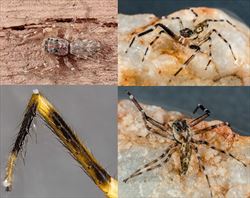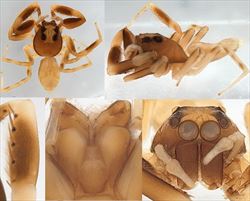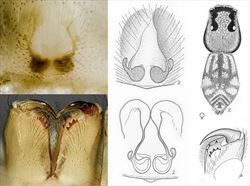
Examples of live Arasia mullion (TL) and Arasia mollicoma
Illustrators (and ©) G.J. Anderson & I.R. Macaulay

Aspects of the general morphology of Arasia mollicoma
Illustrator (and ©) B.J. Richardson (CSIRO)

Dorsal view, epigyne and chelae morphology of Arasia mollicoma
Illustrators (and ©) R. Whyte (L) & M. Żabka (QMB)

Palp morphology of Arasia mollicoma
Illustrators (and ©) M. Żabka (T) (QMB), B.J. Richardson (CSIRO)
Arasia Simon, 1901
Taxonomy
Arasia has two Australian species: Arasia mollicoma and A. mullion. A New Guinea species, A. eucalypti, is likely to occur in Far North Queensland. The genus is part of an Australasian clade (Maddison et al 2008) including Adoxotoma, Astia, Astilodes, Helpis, Jacksonoides, Megaloastia, Parahelpis, Sondra and Tauala. Genera from Indonesia (Katya) and the Philippines (Orthrus) may also be part of this group (Maddison 2015). Further information on the genus and described species can be found in Richardson and Żabka (2017) and Whyte and Anderson (2017).
Description
Arasia spp. are slender, somewhat flattish, medium-sized spiders, ranging in body length from 5 to 9 mm. The head viewed from above is rounded, widest behind the posterior lateral eyes. From the side the carapace is horizontal until the posterior lateral eyes. The abdomen is elliptical, somewhat squared-off at the front, in females much wider just past the mid-point. The chelicerae have five retromarginal teeth (plurident) with three or more teeth on the promargin. The legs are long, the first pair being slightly larger than the others, with five or six pairs of spines on the tibia and three pairs on the metatarsus.
The male’s palp has an extremely elongated cymbium and a long, ribbon-like embolus arising from a compact bulb in the proximal third on the ventral surface of the tegulum and continuing almost all the way to the distal edge of the cymbium. The tibia has a small retro-lateral tibial apophysis and sometimes an indistinct, square-shaped, ventral apophysis.
The female’s simple epigyne features small spermathecae visible just anterior to the epigastric fold and at the base of a triangular depression with its apex anterior. The insemination ducts open near the apex of the triangle and then follow the sides of the triangular depression, ultimately leading to the spermathecae. Glands can be seen on the lateral sides of the ducts.
Biology
Arasia spp. are found in dry to wet sclerophyll forest living on the ground in leaf litter, on grass and on tree trunks, under and on bark, especially on pale-trunked gum trees, against which it is often well-camouflaged by its pale colouration. Arasia spp. are capable of rapid movement and are able to colour match the trunk (grey, white or orange) with the silk of its egg sac.
Distribution
Arasia is found in moderate to higher rainfall areas of Queensland, Northern Territory, New South Wales and the Australian Capital Territory.
References
Davies, V.T. & Żabka, M. 1989. Illustrated keys to the genera of jumping spiders (Araneae: Salticidae) in Australia. Memoirs of the Queensland Museum 27, 189-266.
Gardzińska, J. 1996. New species and records of Astieae (Araneae: Salticidae) from Australia and Papua New Guinea. Memoirs of the Queensland Museum 39, 297-305.
Gardzińska, J. & Żabka, M. 2010. A new genus and five new species of Astieae (Araneae: Salticidae) from Australia, with remarks on distribution. Zootaxa 2526, 37-53.
Maddison, W.P. 2015. A phylogenetic classification of jumping spiders (Araneae: Salticidae). Journal of Arachnology 43, 231-292.
Richardson, B.J. & Żabka, M. 2017. Salticidae. Arachnida: Araneomorphae. Canberra, Australian Faunal Directory. Australian Biological Resources Study, at https://biodiversity.org.au/afd/taxa/SALTICIDAE.
Wanless, F.R. 1988. A revision of the spider group Astieae in the Australian Region. New Zealand Journal of Zoology 15, 81-172.
Whyte, R. & Anderson, G. 2017. A field guide to the spiders of Australia. Clayton: CSIRO Publishing 451pp.
Żabka, M. 2002. Salticidae (Arachnida: Araneae) from the Oriental, Australian and Pacific Regions, XV. New species of Astieae from Australia. Records of the Australian Museum 54, 257-268.
* The information sheet should be interpreted in the context of the associated diagrams and photographs. Diagrams explaining anatomical terms can be found in the ‘Salticidae’ pictures at the beginning of the list of genera.